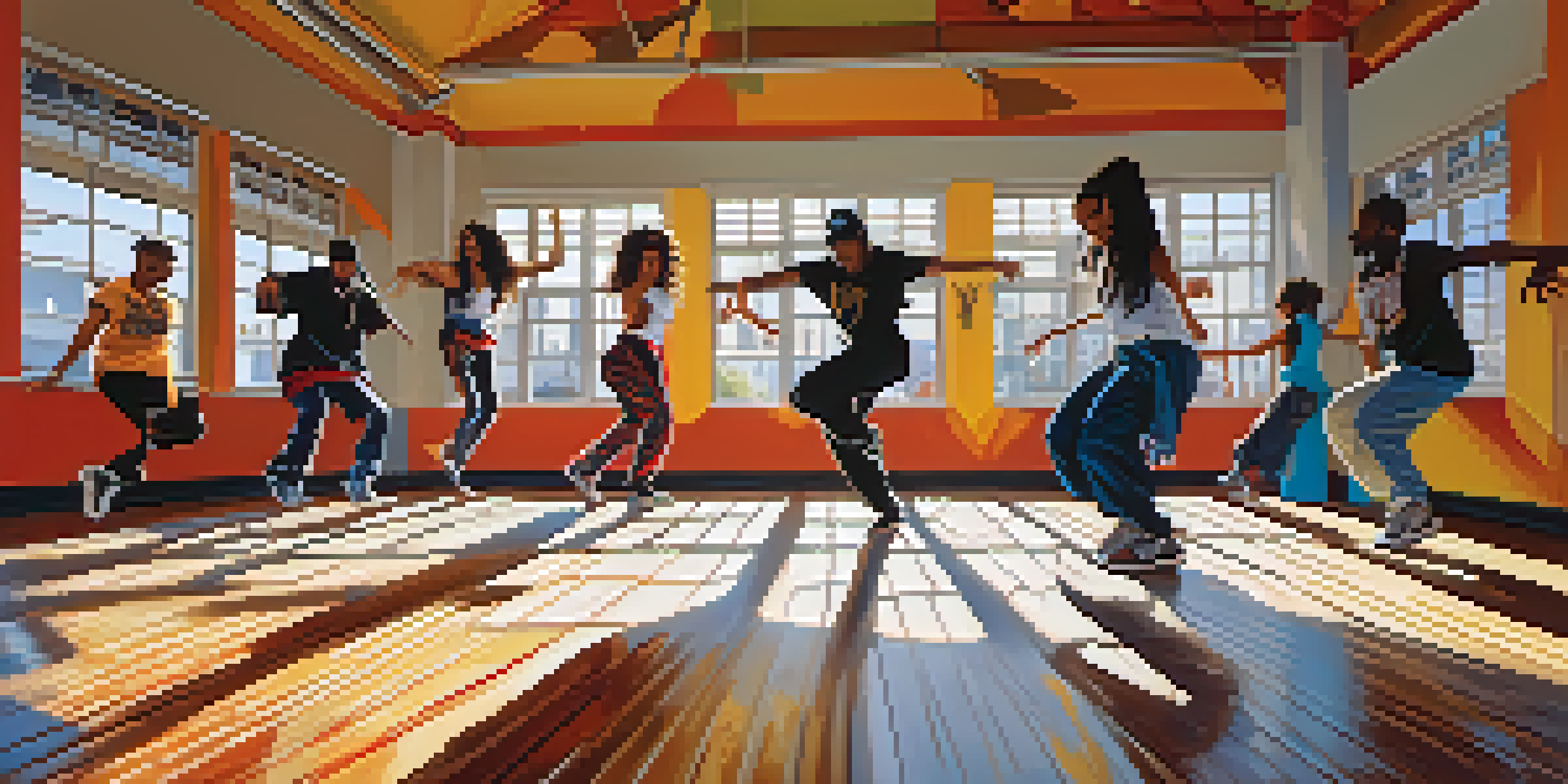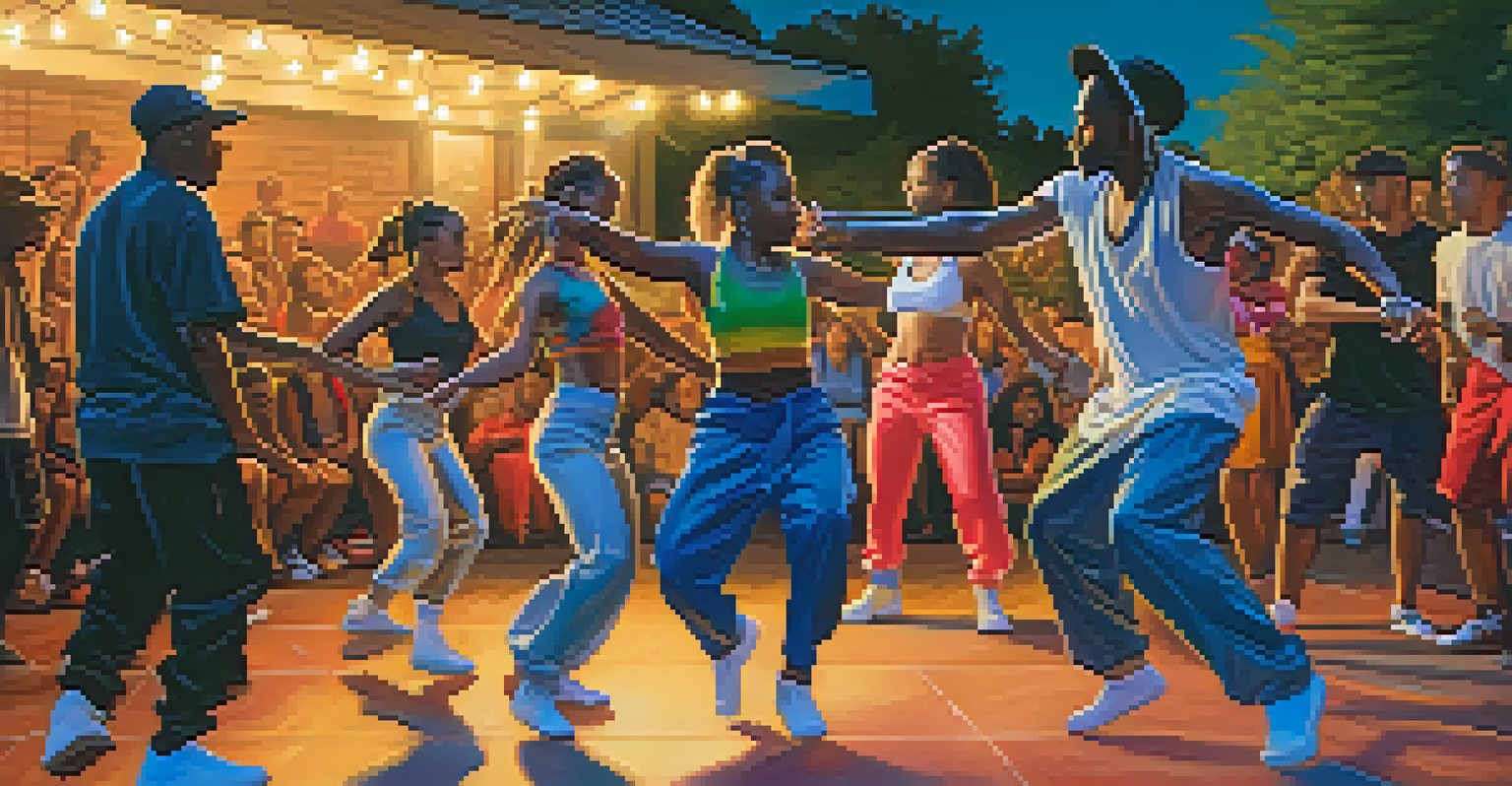The Debate Over Cultural Appropriation in Hip-Hop Dance

Understanding Cultural Appropriation in Dance
Cultural appropriation refers to the act of taking or borrowing elements from one culture by members of another culture, often without permission or understanding. In the context of hip-hop dance, this can manifest when dancers from different backgrounds adopt styles that originated in Black and marginalized communities. It raises questions about respect, acknowledgment, and the implications of using cultural expressions that are not one's own.
Cultural appropriation is when you take something from a culture that you don't belong to, and it can often lead to misunderstanding and disrespect.
For example, consider a dance studio where a white instructor teaches a hip-hop routine that incorporates moves rooted in African American culture. If the instructor fails to pay homage to the origins of these moves, it can feel disrespectful to those who created and have historically practiced them. This scenario highlights the delicate balance between appreciation and appropriation in dance.
Understanding cultural appropriation is crucial for fostering dialogue about respect and recognition in the arts. Hip-hop dance is not just a series of moves; it embodies history, struggle, and identity. Therefore, acknowledging these elements is essential to ensure that cultural expressions are celebrated rather than commodified.
The Roots of Hip-Hop Dance and Its Cultural Significance
Hip-hop dance originated in the 1970s in the Bronx, New York, as part of a broader cultural movement that included music, art, and fashion. It was a vibrant response to social and economic challenges faced by Black and Latino communities. The dance styles—such as breakdancing, locking, and popping—carry stories of resilience and creativity, making them integral to hip-hop culture.

Each dance style has its own unique history and significance, often influenced by the experiences of the communities that created them. For instance, breakdancing emerged as a way for young people to express themselves and compete without resorting to violence. This rich heritage is what makes the appropriation of these styles potentially problematic, as it can strip away their cultural context.
Cultural Appropriation in Dance
Cultural appropriation in hip-hop dance raises important questions about respect and acknowledgment of its origins.
When dancers outside these communities perform hip-hop styles without understanding or acknowledging their origins, they risk diminishing the cultural significance embedded in the movements. This can lead to a disconnect between the dance and its roots, which many dancers and enthusiasts find troubling.
Perspectives from the Hip-Hop Community
Within the hip-hop community, opinions on cultural appropriation can vary widely. Some artists and dancers argue that hip-hop is inherently a fusion of influences and that borrowing from different cultures is a natural progression. They believe that dance, like music, should be inclusive and evolve through cross-cultural exchange.
Hip-hop is a culture, a way of life, and a form of expression. It’s essential to honor its origins while allowing it to evolve.
On the other hand, many within the community emphasize the importance of respecting the origins of hip-hop dance. They argue that when people from outside the culture capitalize on these moves without acknowledging their history, it perpetuates a cycle of erasure. For them, cultural appropriation feels like a theft of identity, rather than a celebration of diversity.
This debate is ongoing and reflects broader societal discussions about race, privilege, and representation. As hip-hop continues to gain global popularity, navigating these perspectives is essential for fostering understanding and respect.
The Role of Education in Hip-Hop Dance
Education plays a pivotal role in addressing the complexities of cultural appropriation in hip-hop dance. By understanding the history and significance of the movements, dancers can appreciate the contributions of the communities that created them. Workshops, classes, and discussions that focus on the cultural context of hip-hop can help bridge the gap between appreciation and appropriation.
Many studios are beginning to incorporate cultural education into their curriculums, allowing students to learn not just the steps but also the stories behind them. This approach fosters a deeper connection to the art form and encourages respect for its origins. Dancers who understand the cultural significance of their practice are more likely to approach it with sensitivity.
Education's Role in Hip-Hop Dance
Integrating cultural education into hip-hop dance curricula fosters respect and understanding of the movement's historical significance.
Furthermore, engaging with members of the hip-hop community can provide invaluable insights and perspectives. Collaborations and mentorships can enhance the learning experience, allowing dancers to honor the culture while developing their skills.
Examples of Positive Cultural Exchange
Despite the complexities of cultural appropriation, there are numerous examples of positive cultural exchange in hip-hop dance. Collaborations between dancers from different backgrounds can lead to innovative fusions of styles that celebrate diversity while respecting origins. These partnerships often provide a platform for dialogue and understanding, highlighting the beauty of shared experiences.
For instance, when dancers from various cultures come together to create a performance that honors both their unique styles and the roots of hip-hop, it can result in powerful storytelling. This type of collaboration not only enriches the dance but also educates audiences about the cultural significance behind each movement.
Such positive exchanges demonstrate that, when approached thoughtfully, cultural borrowing can foster inclusivity and appreciation. By celebrating the interconnectedness of cultures, dancers can create a vibrant community that honors traditions while embracing innovation.
The Impact of Social Media on Cultural Appropriation Debates
Social media has transformed the way cultural appropriation debates are discussed, especially in the realm of hip-hop dance. Platforms like Instagram and TikTok allow dancers to share their work with a global audience, but they also amplify conversations about cultural sensitivity. Viral trends can sometimes overshadow the origins of dance styles, leading to concerns about appropriation.
For example, when a hip-hop dance challenge goes viral, it often attracts participants who may not have a deep understanding of the cultural context. While the challenge may promote creativity and fun, it can also raise questions about who gets to participate and how they represent the culture. This dynamic has sparked discussions among dancers and fans about the importance of acknowledging the roots of the movements.
Positive Cultural Exchange Examples
Collaborations between dancers from diverse backgrounds can lead to innovative styles that celebrate cultural roots and foster inclusivity.
Social media also serves as a platform for advocacy and education. Dancers and educators can use these channels to share resources, engage in discussions, and promote awareness about the significance of cultural appropriation in hip-hop dance. By fostering these conversations, social media can help create a more informed community.
Future Directions for Hip-Hop Dance and Cultural Respect
As hip-hop dance continues to evolve, finding a balance between creative expression and cultural respect will be crucial. The future of hip-hop dance can thrive by promoting a culture of education and awareness, encouraging dancers to explore the roots of the styles they practice. This approach not only enriches their dance journey but also fosters a deeper appreciation for the cultures involved.
Additionally, creating more inclusive spaces within the dance community can help bridge cultural divides. Encouraging collaboration between dancers from different backgrounds can lead to innovative creations that respect and celebrate diverse influences. By prioritizing inclusivity, the hip-hop dance community can ensure that all voices are heard and valued.

Ultimately, the future of hip-hop dance lies in nurturing a culture of respect and understanding. By learning from each other and recognizing the significance of cultural origins, dancers can create a vibrant, inclusive community that honors the past while embracing the future.